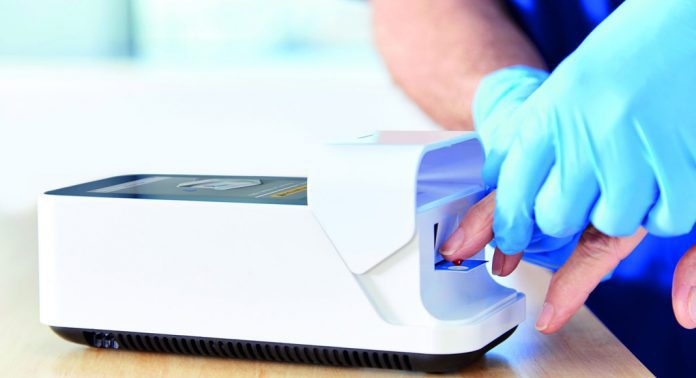
With its advanced point-of-care testing abilities, the LumiraDx platform is enhancing the delivery of care for both patients and healthcare practitioners.
Founded in 2014, LumiraDx is transforming point-of-care testing (POCT) with an ever-increasing portfolio of innovative diagnostic tools aimed at improving the use, accessibility, and accuracy of rapid testing across various areas of healthcare. Health Europa spoke to Lucy Lehane (LL) Associate Director, Medical Affairs at LumiraDx, and Dr Rogier Hopstaken (RH) general practitioner from the Netherlands to find out more about the impact of POCT, specifically CRP, on patient care.
What did LumiraDx learn about point-of-care testing during the pandemic?
LL: In the last few years, LumiraDx has been pleased to be able to make an important contribution with our SARS- CoV-2 antigen and antibody test. The flexibility offered in the design and manufacturing of the test strip meant we were able to respond and adapt quickly to address the needs of the market.
There were also advances for other products in our portfolio during the last year or so. During the pandemic, one of our customers (a GP surgery) set up a drive-through testing hub for international normalised ratio (INR) testing as patients taking warfarin medication need to have their INR levels checked regularly. Using the LumiraDx Platform along with our INR Test strips, and a simple finger prick blood sample, the doctor was able to manage patients’ medications and interact with them in a safe way.
How prevalent is POCT in community settings?
LL: Point-of-care testing is by no means a new thing, but what is different is the accuracy of the LumiraDx platform to take tests to the point of need because patients are not only in hospital or their doctor’s surgery, they are in the community and in potentially remote locations. The size, speed, and flexibility of our technology therefore enables us to go where patients want and need to be tested and deliver results in conjunction with their doctor. Our instrument is very portable and can run on a battery for up to 50 tests, plus, patients’ results can be delivered directly to their electronic health record.
Populations are expanding and people are living longer, many with chronic health conditions which need to be closely monitored. Patients want to be in control of their health and their medication, so to be able to see their doctor doing a test in front of them, whether it is taking a finger prick of blood, like in CRP or D-Dimer testing, or using a throat swab as with COVID, it really helps to build that relationship and understand in more detail, what the doctor is telling them.
How is C-Reactive Protein (CRP) testing supporting diagnostics in the community?
LL: We achieved CE marking and launched our CRP test at the beginning of this year. The test requires a very small amount of finger-prick blood, whole blood or plasma. One of our customers at the Liverpool Heart and Chest Hospital is using our CRP test to support patients who have a diagnosis of COPD, bronchiectasis and/or pneumonia as part of their community care. The respiratory team visits patients in the community and they are able to measure CRP at point of care, when needed, within four minutes. Respiratory matron for Knowsley Community Respiratory Service, Onnor Hampson said: ‘The LumiraDx platform is so easy to use, highly portable and with the ability to use the connectivity function for transfer of results into the patient’s health records – it is a great feature. We are happy to have the LumiraDx CRP Test as part of our community respiratory pathway.’
One of the great benefits of the LumiraDx Platform is the ease of use. The Platform has been designed to work using one simple workflow, irrespective of the test you are running. This means it is straightforward to learn and understand how to use it. Our team of highly-skilled technical experts are on hand to provide superb quality training so that customers are able to be up and running using the test within a short time. We endeavour to make the process from sample collection to obtaining the test result seamless.
What is next for LumiraDx?
LL: There are so many needs that can be fulfilled with the platform. Now we are moving towards this post- pandemic era, we are reflecting on what we have learned so far and considering the important areas of medicine that will need point-of-care testing and how can we support that. A real area of burden is antimicrobial resistance (AMR) particularly in the field of respiratory medicine. Unfortunately, AMR has not had the attention that it needs or deserves in recent years whilst the world has had to focus on fighting COVID-19.
The research and the evidence around the use of CRP testing at POC to guide antibiotic prescribing is well known and the LumiraDx Platform is perfectly positioned to support this.
Our technology can lend itself to many more tests. For instance, our SARS-CoV-2 and Flu A/B Test can help answer the question ‘is it COVID-19 or is it flu?’ It can be used to verify potential infection quickly with a microfluidic assay that provides actionable and lab-comparable results in 12 mins for patients suspected of flu and/or COVID-19, to help decision making and guide treatment.
Likewise, D dimer is one of the other analytes we can measure. The test can be used as an aid in the assessment and diagnosis of patients with suspected venous thromboembolism (VTE) such as deep vein thrombosis (DVT) and pulmonary embolism (PE).
In the near term, we are working on HbA1c, which is a test used for the monitoring of long-term glycemic control in individuals with diabetes mellitus, and as an aid in identifying patients who may be at risk for developing diabetes. That is going to be a new therapeutic area for us and one where the LumiraDx highly accurate technology will be able to make a big difference. We will continue to focus on the development of a broad test menu across conditions diagnosed and managed in community-based healthcare settings providing simple, accessible and affordable point of care testing on our state-of-the-art Platform.
You recently published a study in British Journal of General Practice: ‘Implementing point-of-care CRP testing for better diagnosis of acute respiratory infections.’ From your work, can you share some of the key benefits of CRP testing in primary care?
RH: We carried out several studies to ascertain the value of CRP testing compared to the clinical work-up a doctor routinely carries out. After we had concluded that CRP improves the diagnosis of pneumonia considerably [ref Hopstaken BJGP 2003], we introduced CRP point-of-care testing into general practice [ref Cals BMJ 2011], and very recently in nursing homes [ref Boere BMJ 2021] in the Netherlands to find out if it results in better patient management and better antibiotic stewardship. Doctors who used CRP POCT safely prescribed 30% less antibiotics.
The findings from our studies reflect the current landscape of antibiotic prescriptions in the Netherlands where the country prescribes significantly fewer antibiotics compared to other European countries. If CRP POCT results in less AB prescribing in the NL, one of the lowest AB prescribing countries worldwide, introduction of CRP POCT could lead to even greater reduction of antibiotic prescribing in other countries.
We also found that patient groups who believe that antibiotics were always the right solution for illnesses, felt more appreciated and taken seriously when tested using CRP. This resulted in less use of delayed antibiotic prescriptions [ref Cals Ann of Fam Med 2011]. Focus on enhanced communication skills also improved their interaction with patients during consultation and this added to an even greater reduction of antibiotic prescribing [ref Cals BMJ 2011, Little Lancet].
What are the current needs of the POCT market?
RH: There are many POCT devices on the market, but they only test one or a few essential biomarkers required for a GP’s routine care. Particularly for acute diseases, it is helpful to have multiple parameters at the same time or the ability to decide which test is needed for a specific patient. One of the problems up until recently is that there was not one single multi-testing device which is beneficial because doctors get a broader set of useful markers.
Large diagnostic companies have not yet designed this singular device for general practice. The benefit of the LumiraDx POC Platform is that it is suitable for use in GP practices and can facilitate multiple tests in one platform or system.
What are some of the differences in CRP adoption between the Netherlands and the UK?
RH: In many respects, healthcare systems in the UK and the Netherlands are similar but the most prominent difference is the way they are financed.
Clinical commissioning groups in the UK have an allocated budget for GP practices and they must provide a whole spectrum of care with this budget. The introduction of POCT and CRP testing can take funding away from other areas, which is a barrier to entry for implementation.
It is a common misconception that CRP POCT leads to over-testing, as UK doctors sometimes claim. When we looked back at the volume of CRP POCT testing in the Netherlands over the past 10 years, it has been low (three times per week on average per single GP) and stable. It is important to take extra care to follow up with guidelines alongside the implementation of a POC test.
In addition, the UK healthcare system is overwhelmed. This is also true for the Netherlands, but when GPs started testing, they found new energy from the reaction of patients and nurses after experiencing CRP POCT. Today, nearly 80% of all GPs in the country use CRP POCT and have benefited by being open to innovation and change.
What is the potential globally of testing CRP at the point of care to address AMR?
RH: Tackling AMR requires a multi-faceted approach. CRP POCT has enormous potential to curb this problem. In various randomised controlled trials we have witnessed this 30% decrease in antibiotic prescribing by CRP POCT, recently also for vulnerable older adults in nursing homes [ref Boere BMJ 2021] without any complications. This could be applied around the globe and initiate a change in antibiotic prescribing behaviours, particularly when added with focus on changing communication styles and health education interventions.
This article is from issue 21 of Health Europa Quarterly. Click here to get your free subscription today.











